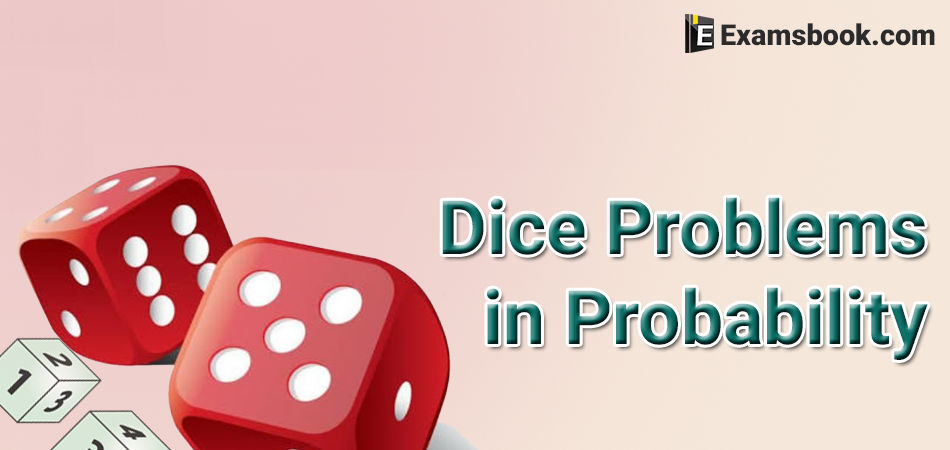Dice Problems in Probability for Competitive Exams

Here are sharing dice problems related to probability with solutions, in this blog. These questions and answers are important for competitive exams. Here are the explained dice problems in probability in detail which will help you to improve your performance.
You just need to understand the topic with these problems and their solutions. So, keep the practice of these questions and strong your preparation. You should visit on Dice Probability Formulas for Competitive Exams to understand using dice formulas to solve dice problems.
Dice Problems in Probability with Solutions
Consider the following points while solving problems:
p(E) = Probability of Event.
n(E) = Total number of favorable outcomes.
n(S) = Total number of Possible outcomes.
Direction (1 to 6): Three dice are thrown together. Find the probability of:
Q.1. Getting a total of 6.
(A) 20/108
(B) 30/100
(C) 5/108
(D) 6/120
Ans . C
Three different dice are thrown at the same time.
Therefore, total number of possible outcomes will be 63 = (6 × 6 × 6) = 216.
getting a total of 6:
Number of events of getting a total of 6 = 10
i.e. (1, 1, 4), (1, 4, 1), (4, 1, 1), (1, 2, 3), (1, 3, 2), (2, 1, 3), (2, 3, 1), (3, 1, 2), (3, 2, 1) and (2, 2, 2).
Therefore, probability of getting a total of 6
= 10/216
= 5/108
Q.2. Getting a total of 5.
(A) 1/36
(B) 2/18
(C) 1/8
(D) 1/30
Ans . A
Three different dice are thrown at the same time.
Therefore, total number of possible outcomes will be 63 = (6 × 6 × 6) = 216.
getting a total of 5:
Number of events of getting a total of 5 = 6
i.e. (1, 1, 3), (1, 3, 1), (3, 1, 1), (2, 2, 1), (2, 1, 2) and (1, 2, 2)
Therefore, probability of getting a total of 5
= 6/216
= 1/36
Q.3. Getting a total of at most 6.
(A) 6/54
(B) 53/54
(C) 5/54
(D) 54/53
Ans . C
Three different dice are thrown at the same time.
Therefore, total number of possible outcomes will be 63 = (6 × 6 × 6) = 216.
getting a total of at most 6:
Number of events of getting a total of at most 6 = 20
i.e. (1, 1, 1), (1, 1, 2), (1, 2, 1), (2, 1, 1), (1, 1, 3), (1, 3, 1), (3, 1, 1), (2, 2, 1), (1, 2, 2), (1, 1, 4), (1, 4, 1), (4, 1, 1), (1, 2, 3), (1, 3, 2), (2, 1, 3), (2, 3, 1), (3, 1, 2), (3, 2, 1) and (2, 2, 2).
Therefore, probability of getting a total of at most 6
= 20/216
= 5/54
Q.4. Getting a total of at most 5
(A) 4/100
(B) 5/108
(C) 6/36
(D) 18/54
Ans . B
Three different dice are thrown at the same time.
Therefore, total number of possible outcomes will be 63 = (6 × 6 × 6) = 216.
getting a total of at most 5:
Number of events of getting a total of at most 5 = 10
i.e. (1, 1, 1), (1, 1, 2), (1, 2, 1), (2, 1, 1), (1, 1, 3), (1, 3, 1), (3, 1, 1), (2, 2, 1) and (1, 2, 2).
Therefore, probability of getting a total of at most 5
= 10/216
= 5/108
Q.5. getting a total of at least 6.
(A) 8/90
(B) 7/65
(C) 6/36
(D) 5/108
Ans . D
Three different dice are thrown at the same time.
Therefore, total number of possible outcomes will be 63 = (6 × 6 × 6) = 216.
getting a total of at least 6:
Number of events of getting a total of less than 6 (event of getting a total of 3, 4 or 5) = 10
i.e. (1, 1, 1), (1, 1, 2), (1, 2, 1), (2, 1, 1) (1, 1, 3), (1, 3, 1), (3, 1, 1), (1, 2, 2), (2, 1, 2), (2, 2, 1).
Therefore, probability of getting a total of less than 6
= 10/216
= 5/108
Therefore, probability of getting a total of at least 6 = 1 - P(getting a total of less than 6)
= 1 - 5/108
= (108 - 5)/108
= 103/108
Q.6. Getting a total of at least 5.
(A) 36/54
(B) 35/45
(C) 53/54
(D) 54/55
Ans . C
Three different dice are thrown at the same time.
Therefore, total number of possible outcomes will be 63 = (6 × 6 × 6) = 216.
getting a total of at least 5:
Number of events of getting a total of less than 5 = 4
i.e. (1, 1, 1), (1, 1, 2), (1, 2, 1) and (2, 1, 1).
Therefore, probability of getting a total of less than 5
= 4/216
= 1/54
Therefore, probability of getting a total of at least 5 = 1 - P(getting a total of less than 5)
= 1 - 1/54
= (54 - 1)/54
= 53/54
Feel free and ask me in the comment section related dice problems in probability if you face any problem. Visit to the next page for more practice.



